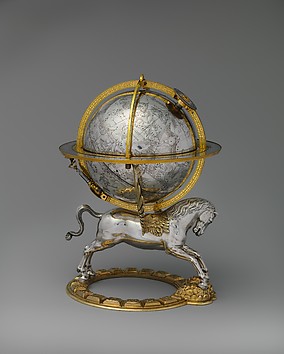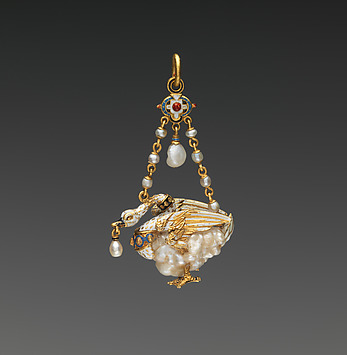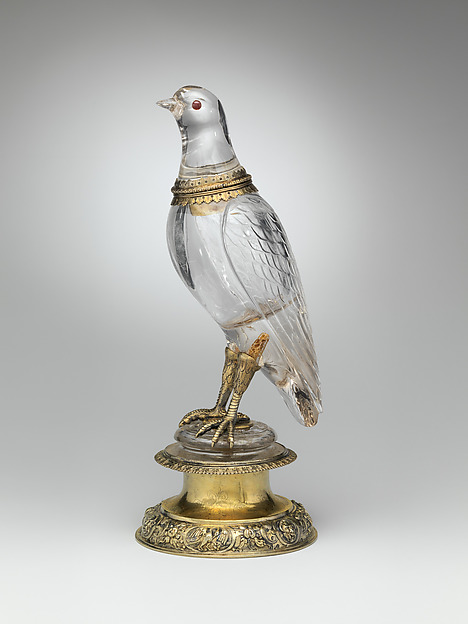Relative Values at
the Met
 Just as you'd expect, Relative
Values at the Metropolitan Museum of Art, with its splendid 16th
century tapestries, jewels, sculpture and works of art is a beautiful show, even
illuminating. The surprise is that its also fun—with no dumbing down along the
way it tells the bracing story of the shifting fates of price and value. See it if you can. There’s lots of time—it doesn’t close until June next year. Congratulations to curator Elizabeth Cleland .
With seeming effortlessness—and wit—she has produced a terrific show ; one with a
timely and important story to tell. The
success of the exhibition is in part the result of the choice of these magnificent 62 works most from the Met's collection. But it
is also due to Ms Celeland’s intelligent, cunning and amusing choice of assistants. Bring on the cows. Or if we are talking about the Celestial Globe above, bring on a herd of them.
Just as you'd expect, Relative
Values at the Metropolitan Museum of Art, with its splendid 16th
century tapestries, jewels, sculpture and works of art is a beautiful show, even
illuminating. The surprise is that its also fun—with no dumbing down along the
way it tells the bracing story of the shifting fates of price and value. See it if you can. There’s lots of time—it doesn’t close until June next year. Congratulations to curator Elizabeth Cleland .
With seeming effortlessness—and wit—she has produced a terrific show ; one with a
timely and important story to tell. The
success of the exhibition is in part the result of the choice of these magnificent 62 works most from the Met's collection. But it
is also due to Ms Celeland’s intelligent, cunning and amusing choice of assistants. Bring on the cows. Or if we are talking about the Celestial Globe above, bring on a herd of them.
But before introducing the cast of cows:
They pieces are grouped by theme: Raw Material, Natural World,
Virtuosity, Technological Advances, Utility, Recreation and Fame. I try to ignore themes but these at least serve a purpose:. They spotlight the value of different materials in
the 16th century, the admiration for some skills and
indifference to others, the time needed to create a piece and the tastes of increasingly competitive rich collectors. This was the recipe for how a work was valued--and its price set.
The labels are a treat. Instead of the usual record of dimensions and dates plus a description of what you have just seen with your own eyes, these quickly teach the lesson that is the reason for this show: There works were of dramatically different values==absolute and relative-when they were made than they are today. )And that they were along the way--and may well be tomorrow. The ease with which we are taught this lesson and its staying power is the result of the curator's choice of instructors. Welcome to cows.
In the 16th century the north of Europe was a crazy
quilt of political entities and—crucially here—currencies. It transpires that such factors as the pay of skilled or unskilled workers and the cost of a loaf of bread, the price of a milking cow was the fairly consistent equivalent of 175 grams of silver across these many borders. For that reason the original purchase price of each of the treasures on view is calculated in cows. They do their job well.
The black silhouette of a cow, facing left, appears on every label. She
is followed by the multiplication symbol and a number. The oil painting on wood panel of “The
Rest of the Flight into Egypt” by a follower of Quentin Metsys, for instance, originally cost COW x 5. The “Celestial Globe” at the
start of this blog, is Cow x 59. “Charity,” a gilded alabaster sculpture: Cow x 40. The fantastical,
enamelled and gem embellished pendants on display cost from
Cow x 35 to Cow x 60.
 The first owner of the gilded silver tankard
fashioned in Augsburg could have bought 5
cows for the same money. As for the elegant rock crystal bird with silver
legs and ruby eyes made in Nuremberg (my favorite in the show), a mighty
shake of the money tree was needed. It cost Cow x 275.
The first owner of the gilded silver tankard
fashioned in Augsburg could have bought 5
cows for the same money. As for the elegant rock crystal bird with silver
legs and ruby eyes made in Nuremberg (my favorite in the show), a mighty
shake of the money tree was needed. It cost Cow x 275. 
This is mooing with a message alright: Neither price nor value are immutable.
When is an artist going to print that on tee shirts and hand them out—or sell them—at Frieze? (Replacing "immutable" with "fixed" won't make the answer yes any sooner.) How many dealers are going to remind their clients that art is a solid investment only if you happen to be in the right place when the music stops. Go to this show. Enjoy the art and take home the message it tells with such charm and ease. In the face of temptation, it is a good one to remember.

No comments:
Post a Comment